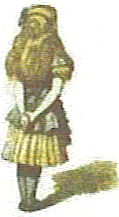Basic Examples
In the early 1960s Grothendieck chose the Greek word topos (which means “place”) to denote a mathematical object that would provide a general framework for his theory of étale cohomology and other variants related to his philosophy of descent. EvenSee: What is a Topos? by Luc Illusie
if you do not know what a topos is, you have surely come across some of them. Here are two examples:
Of course I am looking and trying to describe "Topo" in a different way. I do not want to diminish the significance of the mathematical intents. Just the realization of what we are doing with our perceptions, as we send them to extraordinary depth of of creation.
In 1952, in his book Relativity, in discussing Minkowski's Space World interpretation of his theory of relativity, Einstein writes:
Since there exist in this four dimensional structure [space-time] no longer any sections which represent "now" objectively, the concepts of happening and becoming are indeed not completely suspended, but yet complicated. It appears therefore more natural to think of physical reality as a four dimensional existence, instead of, as hitherto, the evolution of a three dimensional existence. Albert Einstein
Of course it was necessary to understand the evolution of Euclidean geometries to the non-euclidean, and the history associated with this. The word "Toposense" is one that becomes endearing when you realize that if your were to take to the meaning of "slide of light to heart" you would see the implications of what gravity could mean in the presence of the photon and it's explanatory revolutionary ideas about how it can encourage "Gravities Rainbow" here within context of this blog.
"On the Effects of External Sensory Input on Time Dilation." A. Einstein, Institute for Advanced Study, Princeton, N.J.
Conclusion: The state of mind of the observer plays a crucial role in the perception of time.
Unfortunately the link to the article below( now shows as Intuitively Excellent) has been removed from Scientific America's data base or has changed, or, I may of copied it wrong in my search. Nevertheless, I do not have the link, but would like to conclude the remark above, in terms of those pointed out for further repercussions of that conclusiveness.
Einstein scholars disagree, but the pretty girl/hot stove experiment also may have led to another of his pithy remarks, namely: "If we knew what it was we were doing, it would not be called research, would it?" Then again, Einstein was a bit of a wag. Consider his explanation of wireless communication: "The wireless telegraph is not difficult to understand. The ordinary telegraph is like a very long cat. You pull the tail in New York, and it meows in Los Angeles. The wireless is the same, only without the cat." This quote reportedly kept Schrödinger awake well past his bedtime.
Summing over Histories?

So how does all this come together into a physical theory? It turns out that the proper procedure is to construct every possible diagram allowed by the theory (for a given state of input and output particles and how they're moving) and add up the corresponding complex numbers. The result is essentially the "wave function" for that specific input-output state combination, and by squaring that number you can determine the probability that the given input will result in the given output. Doing that is how theorists at particle accelerators earn their keep.See: An Introduction to String Theory by Steuard Jensen
So you look at the basis of interactions that Feynman produced in his Toy models and having some insight to the elemental consideration of those same interactions, what comes out, if we were to see the world in such a way, that continuity of expression is "the Wave that was generated in the very beginning," could have been reduce to some refractive expression of all life. The Spectrum, Hydrogen, or other wise.
Do we then know the nature of the source, that we are all derivatives of some coherent plan that manifests toward the "cyclical nature of being?" Some Shakespearean version of, "to E or not to E?"
Every known particle has an antiparticle; if they encounter one another, they will annihilate with the production of two gamma-rays. The quantum energies of the gamma rays is equal to the sum of the mass energies of the two particles (including their kinetic energies). It is also possible for a photon to give up its quantum energy to the formation of a particle-antiparticle pair in its interaction with matter.
No longer Reducible and Working from the Horizon?

How far can our perceptions be pushed? Can consciousness still remain as part of this "ability of creation," that we are still "part and parcel" of it to consider it's full scope?
So no geometrical idealizations in sight, other then to consider the significance of a place that is far removed from our looking to the cosmos, and while thinking about it, how far it has been reduce to a fuller picture of it's reality?
See: Colour of Gravity


















